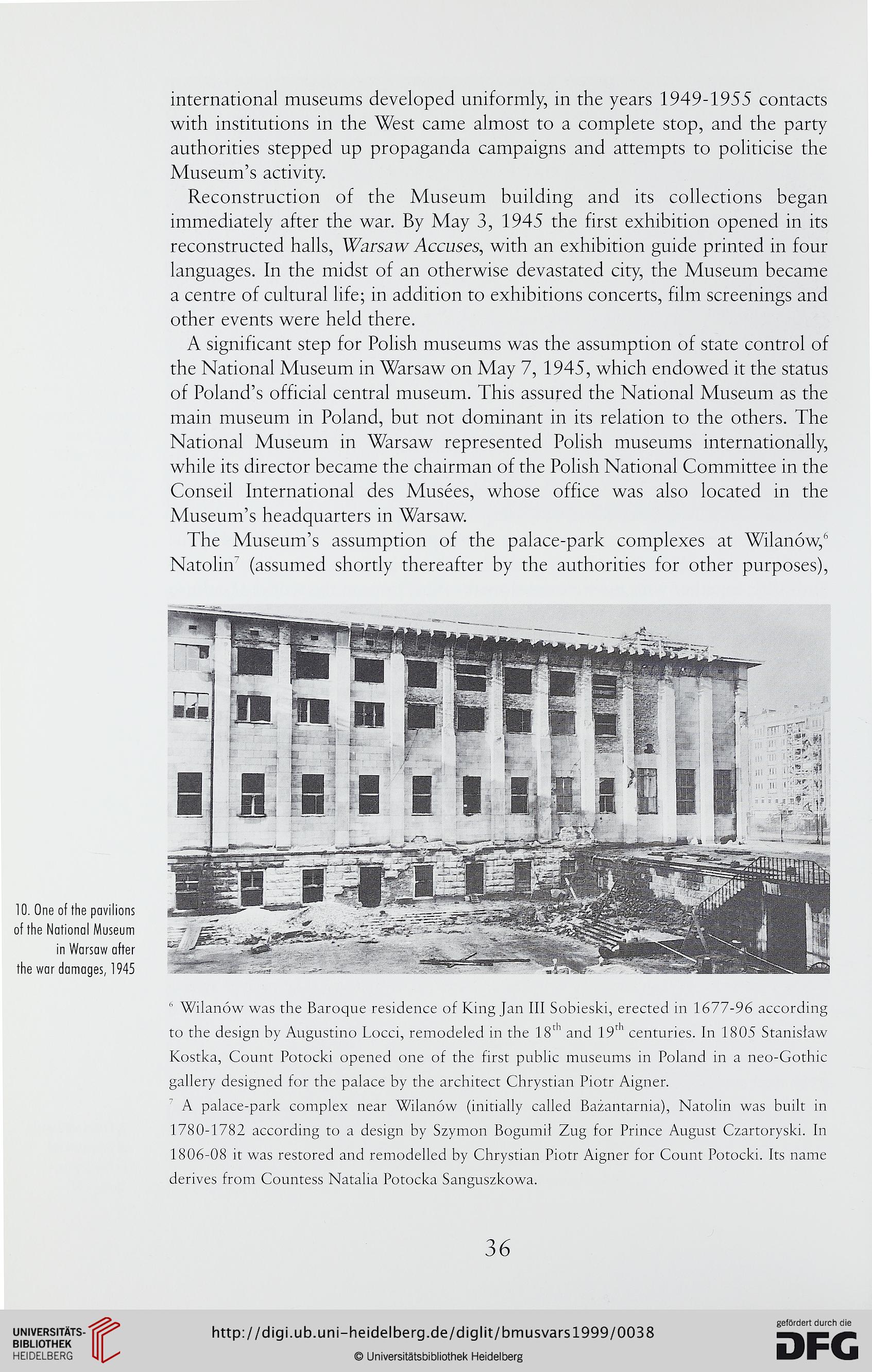international museums developed uniformly, in the years 1949-1955 contacts
with institutions in the West came almost to a complete stop, and the party
authorities stepped up propaganda campaigns and attempts to politicise the
MuseunTs activity.
Reconstruction of the Museum building and its collections began
immediately after the war. By May 3, 1945 the first exhibition opened in its
reconstructed halls, Warsaw Accuses, with an exhibition guide printed in four
languages. In the midst of an otherwise devastated city, the Museum became
a centre of cultural life; in addition to exhibitions concerts, film screenings and
other events were held there.
A significant step for Polish museums was the assumption of State control of
the National Museum in Warsaw on May 7, 1945, which endowed lt the status
of Poland’s official central museum. This assured the National Museum as the
main museum in Poland, but not dominant in its relation to the others. The
National Museum in Warsaw represented Polish museums internationally,
while its director became the chairman of the Polish National Committee in the
Conseil International des Musees, whose office was also located in the
Museum’s headąuarters in Warsaw.
The MuseunTs assumption of the palace-park complexes at Wilanów,6
Natolin (assumed shortly thereafter by the authorities for other purposes),
10. One of the pavilions
of the National Museum
in Warsaw after
the war damages, 1945
6 Wilanów was the Baroąue residence of King Jan III Sobieski, erected in 1677-96 according
to the design by Augustino Locci, remodeled in the 18th and 19th centuries. In 1805 Stanisław
Kostka, Count Potocki opened one of the first public museums in Poland in a neo-Gothic
gallery designed for the pałace by the architect Chrystian Piotr Aigner.
A palace-park complex near Wilanów (initially called Bażantarnia), Natolin was built in
1780-1782 according to a design by Szymon Bogumił Zug for Prince August Czartoryski. In
1806-08 it was restored and remodelled by Chrystian Piotr Aigner for Count Potocki. Its name
derives from Countess Natalia Potocka Sanguszkowa.
36
with institutions in the West came almost to a complete stop, and the party
authorities stepped up propaganda campaigns and attempts to politicise the
MuseunTs activity.
Reconstruction of the Museum building and its collections began
immediately after the war. By May 3, 1945 the first exhibition opened in its
reconstructed halls, Warsaw Accuses, with an exhibition guide printed in four
languages. In the midst of an otherwise devastated city, the Museum became
a centre of cultural life; in addition to exhibitions concerts, film screenings and
other events were held there.
A significant step for Polish museums was the assumption of State control of
the National Museum in Warsaw on May 7, 1945, which endowed lt the status
of Poland’s official central museum. This assured the National Museum as the
main museum in Poland, but not dominant in its relation to the others. The
National Museum in Warsaw represented Polish museums internationally,
while its director became the chairman of the Polish National Committee in the
Conseil International des Musees, whose office was also located in the
Museum’s headąuarters in Warsaw.
The MuseunTs assumption of the palace-park complexes at Wilanów,6
Natolin (assumed shortly thereafter by the authorities for other purposes),
10. One of the pavilions
of the National Museum
in Warsaw after
the war damages, 1945
6 Wilanów was the Baroąue residence of King Jan III Sobieski, erected in 1677-96 according
to the design by Augustino Locci, remodeled in the 18th and 19th centuries. In 1805 Stanisław
Kostka, Count Potocki opened one of the first public museums in Poland in a neo-Gothic
gallery designed for the pałace by the architect Chrystian Piotr Aigner.
A palace-park complex near Wilanów (initially called Bażantarnia), Natolin was built in
1780-1782 according to a design by Szymon Bogumił Zug for Prince August Czartoryski. In
1806-08 it was restored and remodelled by Chrystian Piotr Aigner for Count Potocki. Its name
derives from Countess Natalia Potocka Sanguszkowa.
36




